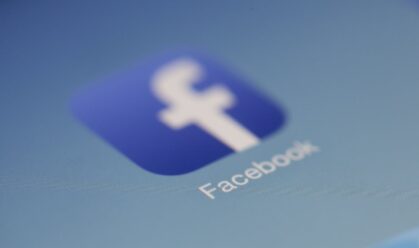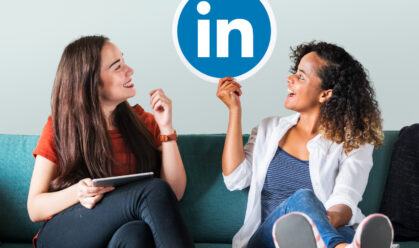One of the biggest challenges for government agencies on social media is humanizing their communications.
You want your audience to feel that you’re friendly, approachable, and genuinely care about their needs — not just another faceless public body.
As part of our December 2023 Social Media Strategy Summit for Public Agencies & Government, Ellen Kamilakis — Assistant District Administrator for Communications at VDOT Northern Virginia — explained how her agency tackled this problem by creating a persona for their social media presence.
Lovingly called “MeeMaw,” this persona helps the agency communicate in a more natural, human tone.
Read on for all the key takeaways from Ellen’s session, including:
- How transparency, timeliness, and humanity are key
- Why being vulnerable is the way to go (even if it feels counterintuitive)
- Best practices to boost perception among residents, news media, and elected officials
Let’s get into it.
Why Showing That You Care Matters
On a human level, we all want to feel like we’re fundamentally good people who care about our audience.
But why does that matter from a marketing perspective?
As the Center for Risk Communication’s Director, Dr. Vincent Covello puts it: “When people are stressed and upset, they want to know that you care before they care what you know.”
In other words, you need to build a relationship with your audience before they give your words any credibility during times of crisis and stress.
And it’s also important to develop messages that recognize, respect, and address people’s fears, emotions, and concerns.

This might sound like second nature to you as a social media professional, but it’s not obvious to everyone.
“I work with a group of engineers. It’s not easy for them to understand because feelings are nebulous, and they don’t have metrics with them, and they’re hard to track,” Ellen explains.
“But feelings are the driving force of what we do as professionals.”
Remember Why People Use Social Media
Social media often gets a bad rap.
In some ways, it’s deserved, with numerous studies linking social media usage to poor mental health outcomes.
But it’s important to remember that social can also be a force for good.
As Ellen points out: “People that have better mental health when they come to social media are seeking to find happiness and joy and uplifting and lighthearted social media content. And they, especially, want the human perspective.”
That’s why humor has become a key element of VDOT Northern Virginia’s social media strategy.
When you see that yellow/black, white/red pattern on the plates of the car in front of you. https://t.co/RuEAVSGkIQ
— VDOT Northern VA (@VaDOTNOVA) July 21, 2021
“People who are participating in this type of thread will know that VDOT is out there and that we also have a good sense of humor with things,” Ellen explains.
Building a Social Media Community
Think about your own network for a second: how many loved ones do you communicate with via multiple platforms?
You might tag them in a meme on Instagram, email them, and text them — all on the same day.
It works the same way for government agencies: when people engage with you through several different platforms, they’re more likely to build a closer connection with you.
However, it’s important to remember that building a community on social media is tough. It might take weeks, months, or years of sharing helpful content and being there for your audience before you start seeing any tangible reward.

“You’re going to have to put in a lot of work upfront to build your community before you start seeing any of the benefits,” Ellen explains. “You have to be prepared for that — and your leadership has to be prepared for that.”
Creating the “MeeMaw” Persona
It’s fair to say Ellen didn’t invest a ton of time in strategic planning when coming up with the idea for MeeMaw.
In fact, all it took was a single, short text exchange between Ellen and her boss at the start of the first coronavirus lockdown:
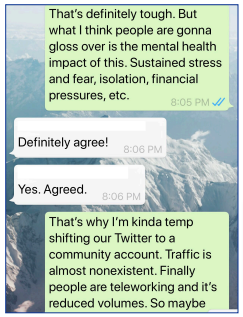
With hundreds of thousands of people in the region shifting to telework and road traffic volumes dropping by as much as 70% on some highways, it no longer made sense for the agency to post about road safety.
“We need to be talking about what our community is going through at the moment, what they fear, and the service that we can provide for them,” Ellen explains of her thought process. “That is to be a friend and to acknowledge what’s going on.”
Given the context, the MeeMaw persona — although, in reality, it’s just Ellen — felt like the obvious solution. “It was what I was dealing with, it was what my friends were dealing with, and I just wanted to give voice to it, validate people, and normalize the feelings that we were all going through.”
Organically, this led to Ellen taking a kind of autobiographical approach to the agency’s social media content.
Rather than pretending to be a Zoomer social media intern, she was upfront about being an “old lady.”
Which, in turn, empowered her to “nag” the agency’s followers about positive behaviors that have nothing to do with transportation — like staying hydrated and keeping warm on cold days.
Morning Missy Message®️
I’m going to channel MeeMaw today and remind you to dress in layers. The morning will be chilly, but not so much later today. #StayWarm #LoveYou pic.twitter.com/85gMz6yvy4
— VDOT Northern VA (@VaDOTNOVA) January 22, 2024
“Being able to be upfront about the fact that I’m older was a good way to preempt anybody saying, ‘Oh, well, thanks, mom,’” she explains.
Posting as a Persona: How To Do It
At this point, Ellen knows something about embodying a persona on social media. Here are her top tips on how to do it yourself:
Always Be Yourself
Ellen is in a slightly unusual position, having essentially turned herself into a social media persona — thereby allowing her to embrace her love of The Silence of the Lambs:

Still, she insists that the best approach to creating social media content is to be yourself, even when posting on a government agency’s behalf.
“We’re all valuable human beings in our own right,” she says. “Your personality is unique, creative, and wonderful. So just be yourself.”
Don’t Be Afraid To Show Vulnerability
Another key element to creating a social media persona that feels human is to be vulnerable.
Because humans, by our very nature, make mistakes.
“We all make typos, so I acknowledge them,” Ellen explains. “People can relate to me and bond with me better if they see me as a human and not a government agency.”
Use Visual Elements
“Posts are gonna do better with videos, GIFs, memes, anything that is not just text,” Ellen says.
Sure, it might sound obvious, but it’s an important element of creating high-quality social media content.
Be Very Online
Think about the times that you browse social media most often.
It’s probably at lunchtime, evenings, and weekends, right?
Most other people are the same. So, if your goal is to build a social media community, you need to be available during those peak periods. “You have to be prepared to meet them where they are,” Ellen insists.
Be Prepared To Deal With Jerks
As Ellen puts it, there’s no shortage of “meanies” on social media. “No matter what you do, they’re gonna have horrible things to say, and you just have to take that.”
Her solution? Build a community of fellow social media pros who know what you’re going through and don’t mind you venting. “It helps diffuse any of the building tension.”
Using MeeMaw in Risk and Crisis Communication
Risks are more feared if they are perceived as:
- Involuntary or imposed
- Inescapable/catastrophic
- Unfair
- Unfamiliar/dreaded
- Man-made
- Threatens children
- Under the control of untrustworthy others
Many of these factors made COVID-19 a perfect storm for risk communications.
For VDOT Northern Virginia, MeeMaw played a key role in its comms strategy. Here are some examples of how that looked in practice:
Providing a Sense of Self and Community Efficacy
This is all about telling people that the efforts they’re putting in are working, just like MeeMaw did here:

Ellen stresses that she didn’t choose this image by chance.
“The dog has a very specific demeanor,” she explains. “We don’t have to say, ‘Everything is very overwhelming, and we have a sense of love for the people that are taking care of things,’ because the dog is conveying this.”
Providing a Sense of Hope
At times of crisis, people often want to see uplifting, motivational content to remind them that not everything’s bad.
If in doubt, say it with cats:
Morning MeeMaw Nag™️:
Never give up on reaching your goals, no matter what they are. #washyourhands #wearamask #loveyou pic.twitter.com/utGiTirO7c
— VDOT Northern VA (@VaDOTNOVA) August 18, 2021
Providing a Sense of Safety
Of course, crisis communication isn’t all fun, games, and positivity. An essential part is sharing valuable messaging that helps people stay safe.
Here’s another example from MeeMaw:
Midday reminder… #WashYourHands #donttouchyourface #loveyou pic.twitter.com/n1H4lvXijC
— VDOT Northern VA (@VaDOTNOVA) March 24, 2020
“We lined up our messaging with what our health department was putting out, so we were incorporating that in as much as possible,” Ellen explains.
Providing a Sense of Calm
Helping people feel calm during a crisis is partly about reassuring them that they’re doing okay.
And even if they’re not, that’s fine, too.
Again, MeeMaw had a post for this:
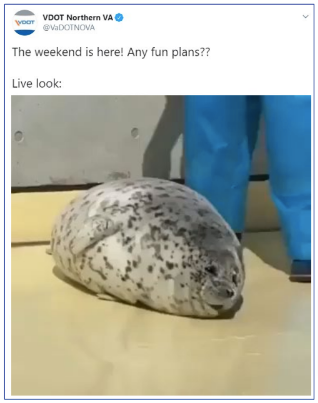
“Let’s be honest, we all just kind of lazed around,” Ellen says. “We were feeling overwhelmed. We were feeling stressed. The seal is normalizing that.”
Providing a Sense of Connectedness
Taking it back to the very start of the pandemic, the first post Ellen shared that focused on mental health rather than transportation was designed to foster a feeling of connectedness and community with VDOT Northern Virginia’s followers:
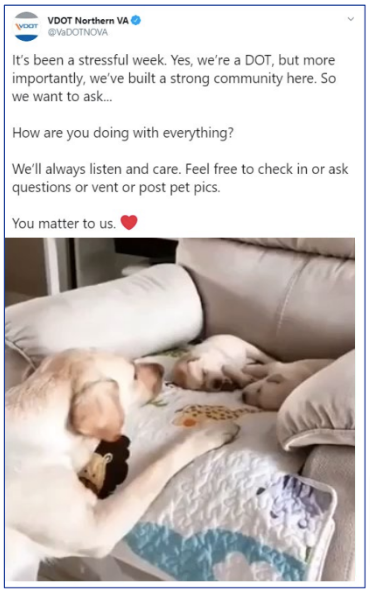
“I was like, ‘Okay, this is horrifying; how do you feel? We’re here. We care about you,’” Ellen says.
What Matters on Social Media?
We’ve looked at some practical examples of what to do during times of crisis.
But what about the rest of the time?
To help you out, Ellen shared her top tips on how to post (and behave) on social media as a government agency:
- Put people first: “There’s nothing more important than the people you’re serving.”
- Be transparent: “There’s very little, unless we’re in a law enforcement organization, that we have the ability to say, ‘We can’t share this with you.’ It’s the work of the public, and everybody’s allowed to know it.”
- Cut people slack: “When people come in hot, you don’t know what’s going on in their lives. Just assume that whatever they’re feeling, they’re allowed to feel, and start from there.”
- Validate all community members: “The more inclusive of a community that we have, it means that we have a larger community. And ultimately, I want the largest audience that I can have to be able to get my messaging out.’
- Be a relatable human: “Be honest about struggles, own typos, all that kind of stuff.”
- Build trust: “Do what you say that you’re going to do. If somebody tells you, ‘Hey, there’s a stop sign down,’ reach out, get it fixed, and let them know “I took care of this for you.’”
- Laugh: “Laughter is absolutely key.”
- Make MeeMaw proud: “Just be a good human being, do the right thing.”
What Results Has MeeMaw Generated?
It’s all good saying things like “laugh” and “be nice,” but it doesn’t count for much in social media if you don’t have the results to back it up.
So it’s important to note that VDOT Virginia has seen a significant upturn in performance since adopting the MeeMaw persona.
Impressed increased massively:
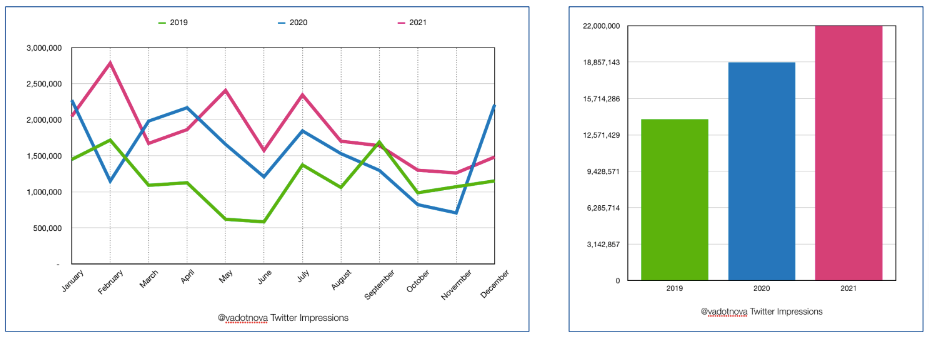
And more importantly, so did the agency’s engagement rate:
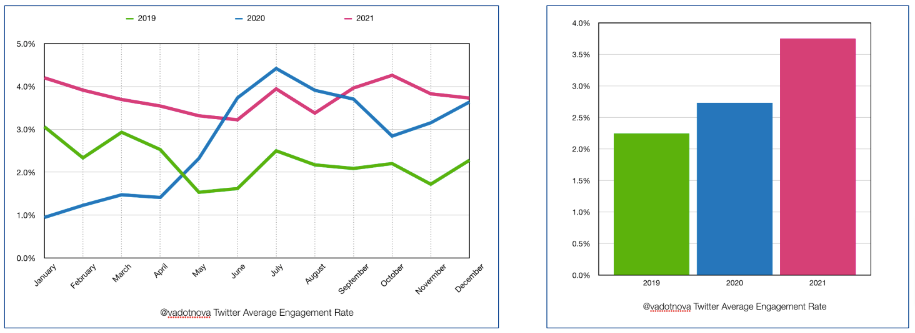
Ellen explains that the point where the blue line starts to climb coincides with MeeMaw’s inception. “That is how people reacted — they wanted to interact.”
MeeMaw attracted the attention of national publishers like the New York Times and even the former governor of Virginia:
I’m sorry, I must be mistaken. I thought that the Governor of our amazing Commonwealth just mentioned us! Pardon me while I pick myself up off the floor.
Governor, thank you so very much for your kind words!!!#virginiaisforlovers #thegovernorknowsmynameomg https://t.co/fbipBhrLKw pic.twitter.com/AsjTKLlSBk
— VDOT Northern VA (@VaDOTNOVA) February 21, 2021
“I had to acknowledge that the governor knows my name,” Ellen says. “It was a fantastic insurance policy on the direction that we were going in.”
Are you interested in learning more about social media for government agencies? Check out our next government social media conference!
Featured image by Pixabay.





